2008 - How Does Your Garden Grow?
2008 - How Does Your Garden Grow?
Please take a moment to comment on your garden food production, including fruit and nut trees. This is about food production only. Please note about particular problems or success you are having. This article will be frozen sometime in September or October and placed on permanent file. I hope to do this every year so we can keep a running tally of our food production through different areas of the US.
“Conspiracy Theories Are Wisps of Smoke From Fires That Cannot Be Seen” - The Watchman (2024)
I might as well start with myself and it isn't much to be proud of. We have a back lot that we are turning into a garden --- slowly but surely ---- this western soil in Wyoming is highly alkaline, with little calcium. We have literally been amending the soil with compost for about 10 years. We're in the process of building permanent beds so that we can micro-manage a particular variety of vegetable. We have built an asparagus bed and the plants are growing nicely  Our two apple trees were hit by late frost and will not produce this year. By all reckoning our apricot tree should have been wiped out too but it has an abundance of apricots and we will can and dry them. Of course our rhubarb and onion patch have flourished.
Our two apple trees were hit by late frost and will not produce this year. By all reckoning our apricot tree should have been wiped out too but it has an abundance of apricots and we will can and dry them. Of course our rhubarb and onion patch have flourished.
Failed to mention that rainfall was good in May, almost non-existent in June, and non-existent in July. Thank God we have a well right next to the garden.
Failed to mention that rainfall was good in May, almost non-existent in June, and non-existent in July. Thank God we have a well right next to the garden.
“Conspiracy Theories Are Wisps of Smoke From Fires That Cannot Be Seen” - The Watchman (2024)
-
bee_pipes

This year we built a seed starter rack and began our seed indoors.

this gave us an early start on seedlings this year
Last year we added two apple, two peach, a cherry and 3 grapes. We had 9 blueberry, 4 fig and a cherry in a spot that was not doing that well, so we moved them and all the fruit trees are in an area convenient to the house and the bee hives. All the figs and the cherry did well with the transplant, lost one blueberry.
Our soil is called chert. It looks like red clay from a distance, but up close you can see it is flinty rock. We have been tilling, layering cardboard and yard waste on top, and applying compost every year. It is beginning to look like soil now - before it looked like a parkinglot. When we plant tomatoes, we grow seedlings as tall as possible, trim all but the top leaves off the stems, and plant them as deeply as possible. Every part of a tomato stem that touches soil will grow roots. They take a while to get started because the plant is putting out roots, but when the tops start growing we wind up with huge plants and they seem to be extremely drought tollerant.
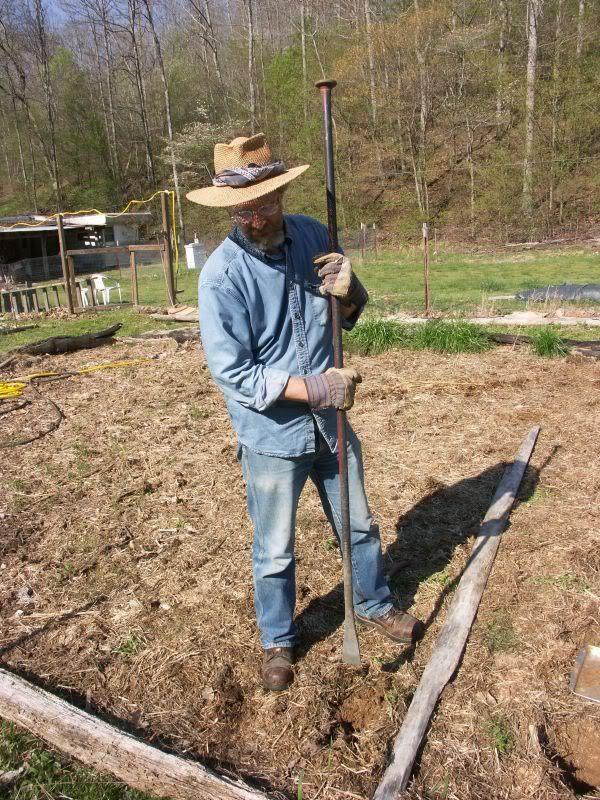
breaking soil with post-hole digger to plant tomatoes deep
A late freeze had us scurrying to cover seedlings in the garden with old milk cartons. My wife used to give me grief about not being willing to part with them. They are handy containers. We painted 30 of them black and use them as solar heat batteries for the greenhouse (filled with water, they soak up heat and moderate nighttime temps in the greenhouse). When the weatherman talked about a late frees we took another 60 of them, cut the bottoms out and set them over seedlings, saving the tomatoes and peppers.
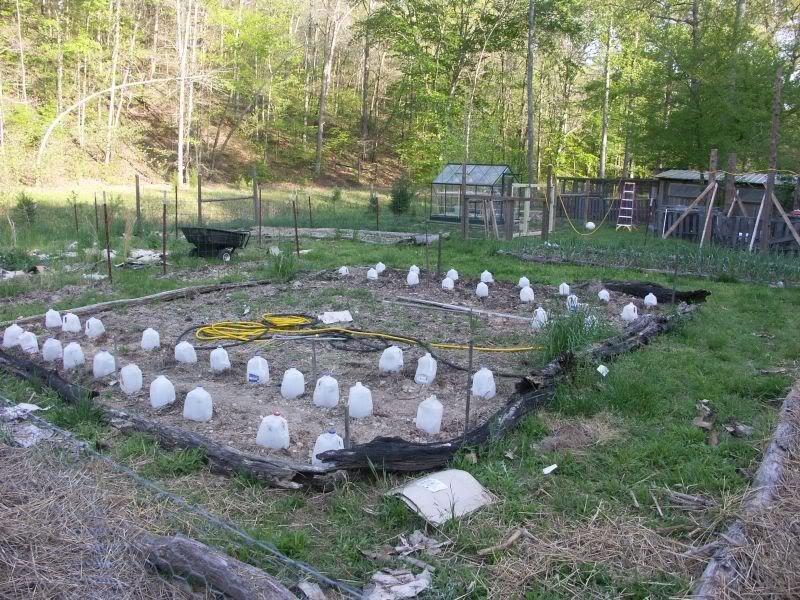
My wife said she'd never complain again about me keeping old milk cartons. We mulched the beans and gourds with straw - they survived the freeze.
Asparagus - on the third year with it - delicious and new plants are coming up from the original plants reseeding themselves. These new plants will take another 2 or three years to mature enough to harvest, but it's like watching interest accrue in a savings account.
This is the first year we didn't try corn. We can buy better corn from the Mennonites than we can grow. We haven't given up on corn entirely, but I'm thinking more along the lines of livestock feed, rather than sweet corn for our consumption. Tomatoes are just starting to turn, as are the wild blackberries. Peppers are doing good, the lettuce has bolted already, and the cabbage looks like swiss cheese and is a total write-off for this year. We have been harvesting green beans for some time and Karen has put up a few quarts of them for the winter. Potatoes are waiting to be dug up and the jurry is still out on sweet potatoes - they were a first time experiment this year.
On the new side, just started this year, I have started cultivation on 1/10 acre for home grain production.
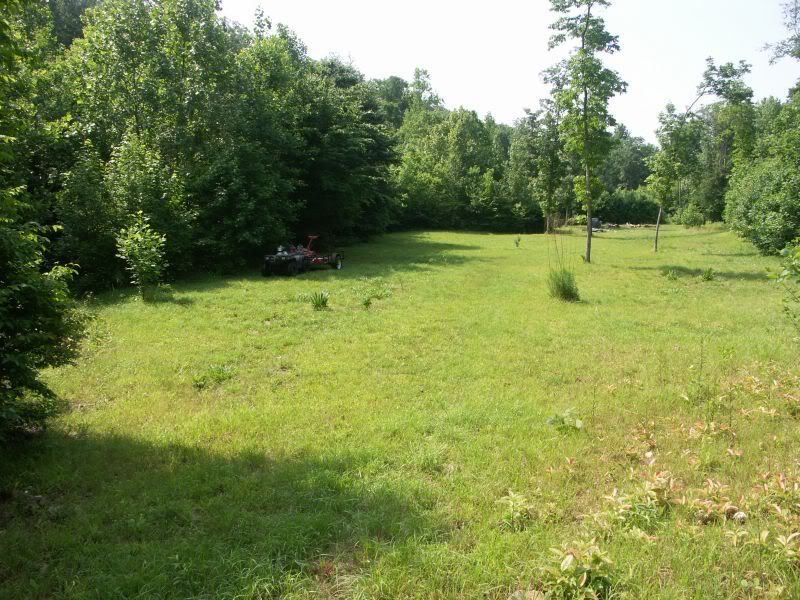
back field after mowing
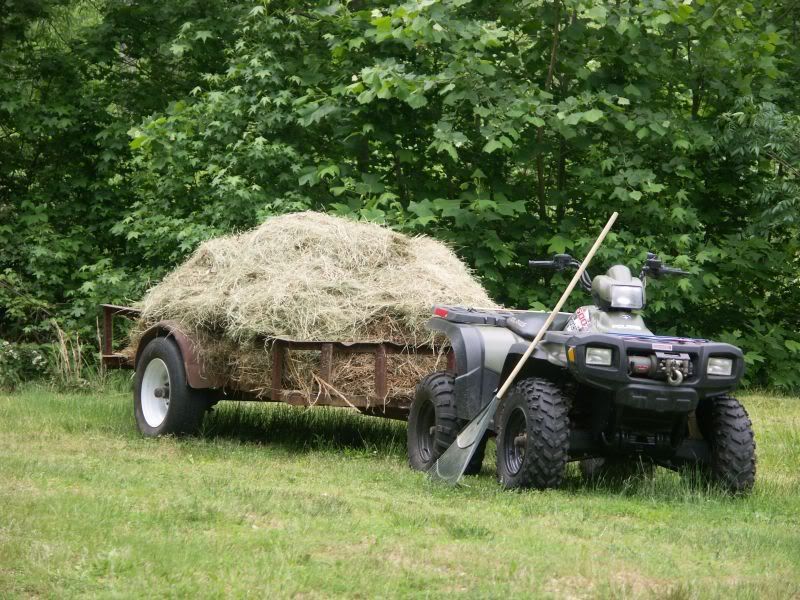
hay harvest used for mulch around fruit trees (my little haywain)
We are breaking up the sod and planting soybeans to improve the soil quality and will be planting wheat this autumn. It doean't sound like much, but the space is too small for a tractor to do a proper job and too big for the husky tiller I am using to do the job.
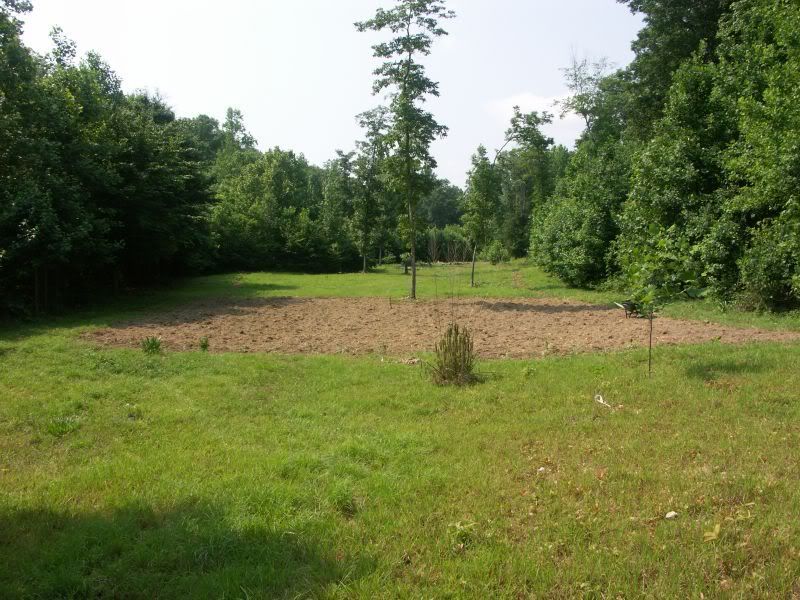
ten days worth of tilling - two hours in morning before the heat gets too bad - about 1/4 of the way done
We are not doing that well on rain here, and I have found that rabbits are particularly fond of soybean plants. We have some growing in the garden - the edible type - that are ebing raised for seed. The ones being planted in the back field are some sort of hybrid franken-plants carried by the coop. The coop seed are strictly for soil improvement, the edibles ones will eventually replace them ane be used for human and livestock feed.
We plan on growing varieties of grain out back and are looking into a manual grain mill for making our own flour and cracking grains for the livestock.
Gourds - I'm still experimenting with those - they are entertaining to grow, and I hope to make useful containers out of some of them.
Oh! And another year's worth of garlic harvested. The last two bunches are curing on the porch. Garlic is a good plant - nothing wants to mess with it. We have 8 or 10 varieties and I am enjoying trying all the new types - they really add some zip to meals - some of them are quite hot.

garlic bed
Regards,
Pat

this gave us an early start on seedlings this year
Last year we added two apple, two peach, a cherry and 3 grapes. We had 9 blueberry, 4 fig and a cherry in a spot that was not doing that well, so we moved them and all the fruit trees are in an area convenient to the house and the bee hives. All the figs and the cherry did well with the transplant, lost one blueberry.
Our soil is called chert. It looks like red clay from a distance, but up close you can see it is flinty rock. We have been tilling, layering cardboard and yard waste on top, and applying compost every year. It is beginning to look like soil now - before it looked like a parkinglot. When we plant tomatoes, we grow seedlings as tall as possible, trim all but the top leaves off the stems, and plant them as deeply as possible. Every part of a tomato stem that touches soil will grow roots. They take a while to get started because the plant is putting out roots, but when the tops start growing we wind up with huge plants and they seem to be extremely drought tollerant.

breaking soil with post-hole digger to plant tomatoes deep
A late freeze had us scurrying to cover seedlings in the garden with old milk cartons. My wife used to give me grief about not being willing to part with them. They are handy containers. We painted 30 of them black and use them as solar heat batteries for the greenhouse (filled with water, they soak up heat and moderate nighttime temps in the greenhouse). When the weatherman talked about a late frees we took another 60 of them, cut the bottoms out and set them over seedlings, saving the tomatoes and peppers.

My wife said she'd never complain again about me keeping old milk cartons. We mulched the beans and gourds with straw - they survived the freeze.
Asparagus - on the third year with it - delicious and new plants are coming up from the original plants reseeding themselves. These new plants will take another 2 or three years to mature enough to harvest, but it's like watching interest accrue in a savings account.
This is the first year we didn't try corn. We can buy better corn from the Mennonites than we can grow. We haven't given up on corn entirely, but I'm thinking more along the lines of livestock feed, rather than sweet corn for our consumption. Tomatoes are just starting to turn, as are the wild blackberries. Peppers are doing good, the lettuce has bolted already, and the cabbage looks like swiss cheese and is a total write-off for this year. We have been harvesting green beans for some time and Karen has put up a few quarts of them for the winter. Potatoes are waiting to be dug up and the jurry is still out on sweet potatoes - they were a first time experiment this year.
On the new side, just started this year, I have started cultivation on 1/10 acre for home grain production.

back field after mowing

hay harvest used for mulch around fruit trees (my little haywain)
We are breaking up the sod and planting soybeans to improve the soil quality and will be planting wheat this autumn. It doean't sound like much, but the space is too small for a tractor to do a proper job and too big for the husky tiller I am using to do the job.

ten days worth of tilling - two hours in morning before the heat gets too bad - about 1/4 of the way done
We are not doing that well on rain here, and I have found that rabbits are particularly fond of soybean plants. We have some growing in the garden - the edible type - that are ebing raised for seed. The ones being planted in the back field are some sort of hybrid franken-plants carried by the coop. The coop seed are strictly for soil improvement, the edibles ones will eventually replace them ane be used for human and livestock feed.
We plan on growing varieties of grain out back and are looking into a manual grain mill for making our own flour and cracking grains for the livestock.
Gourds - I'm still experimenting with those - they are entertaining to grow, and I hope to make useful containers out of some of them.
Oh! And another year's worth of garlic harvested. The last two bunches are curing on the porch. Garlic is a good plant - nothing wants to mess with it. We have 8 or 10 varieties and I am enjoying trying all the new types - they really add some zip to meals - some of them are quite hot.

garlic bed
Regards,
Pat
Jealousy is not a good trait but I am! Trees, green.... Oh well, one of the things I have to bear here in addition to: hardpan clay, alkali, radioactive tailing dust, sagebrush, Russian knap weed, and so on. No forest humus. Our only hope is to micro-manage beds into their own little eco-spheres.
“Conspiracy Theories Are Wisps of Smoke From Fires That Cannot Be Seen” - The Watchman (2024)
-
bee_pipes

-
Toepopper
- ⭐Patriot - Security, Defense, Weaponeering

- Posts: 1238
- Joined: 16 Aug 2007 12:03
- Location: Southwest Oregon
You can make that forest mulch less acidic by mixing in some Dolemite agricultural lime a few weeks before using it in your garden. I use the mulch from under maple trees as this is not as acidic and the garden loves it for the leaf mold.
Most of my established fruit trees are producing fruit with the exception of plums and Kiwi. The cold spring we had was hard on the blossoms and they froze and did not produce this year. All of my transplanted vegetables have been destroyed by woodrats. I have caught a couple of the little !!#?X!^&* in Victor rat traps. They have munched my plants down to ground level and carried them off to line their nest with. Upon searching through the brush around my garden, I have found a 5 foot tall woodrats nest built out of sticks and leaves and have placed a dozen traps around its perimiter. I have the urge to burn them out but can't for fear of starting a forest fire. The 4 types of rasberries, potato's, grapes and bamboo grove are all doing well.
I figured that this was the year we needed the veggies the most, taking into consideration all that is going on in our world, and as luck would have it, I will not have a harvest and will have to buy local at the farmers market in order to can and put up enough to make it another year.
Most of my established fruit trees are producing fruit with the exception of plums and Kiwi. The cold spring we had was hard on the blossoms and they froze and did not produce this year. All of my transplanted vegetables have been destroyed by woodrats. I have caught a couple of the little !!#?X!^&* in Victor rat traps. They have munched my plants down to ground level and carried them off to line their nest with. Upon searching through the brush around my garden, I have found a 5 foot tall woodrats nest built out of sticks and leaves and have placed a dozen traps around its perimiter. I have the urge to burn them out but can't for fear of starting a forest fire. The 4 types of rasberries, potato's, grapes and bamboo grove are all doing well.
I figured that this was the year we needed the veggies the most, taking into consideration all that is going on in our world, and as luck would have it, I will not have a harvest and will have to buy local at the farmers market in order to can and put up enough to make it another year.
